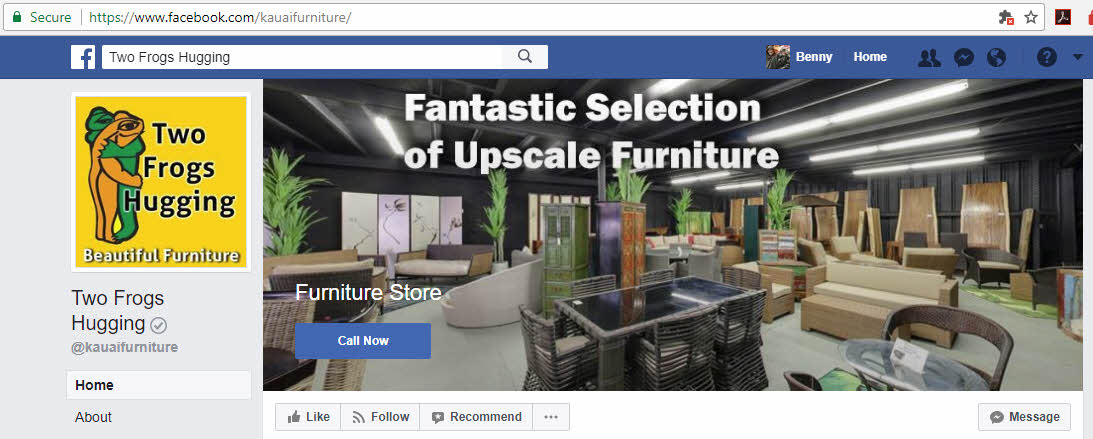Social Media Campaign
The example social campaign shown below is our recommended strategy for obtaining maximum free traffic.
Step 1 – Build Social Profiles
Depending on your industry and target market, select social profiles will be created which serve two purposes:
- Each social profile gives you another potential listing on the first page of Google. The more real estate you own on page 1 of search results, the more leads you get and the better you control your online reputation.
- Each social profile gives you the ability to build online tribes. Since social followers receive notification of your posts, you can leverage social tribes to generate free traffic, leads, appointment or sales, EVERY time you make a post.
Consider creating social profiles in major social platforms, including;
Step 2 – Brand your Social Profiles
Each social profile should have consistent branding with your website. Notice the brand similarity in the profiles shown below:
Facebook:

LinkedIn:

Twitter:

To get the maximum amount of free traffic from your social media package, it should be tightly integrated with your SEO and content marketing efforts.
Rather than merely pushing content out to the social accounts, we leverage the company’s website as a central hub. The goal is to draw social followers into a meaningful business relationship. This often begins on the website, so as a general rule; we try to develop the social campaign in such a way that it facilitates free website traffic, leads, appointments and sales.
The first step in this process is to create interesting content, then publish that content to the company’s website/blog.
We then format this content’s important SEO components such as alt tags, H tags, and keywords, so the content does double-duty as an SEO magnet for Google.
We always add the important (but hidden) social meta tags, including Twitter Markup, Open Graph and Structured Snippets, to allow social platforms such as Facebook to build links back to the company’s website.
This new content builds the authority of the website, and thus helps the company gain SEO traction.
As part of your package, we then syndicate that same content to all major social accounts, including Facebook, Twitter, LinkedIn, Instagram and Pinterest. However, rather than merely copying and pasting the content, if it is formatted correctly, the platforms will allow us to paste the URL of the webpage where the content was originally published. This method of syndication allows the social platforms to pull the relevant content directly from the websites hidden social tags, and consequently, the social platform must point visitors back to the website. This boomerang effect drives free traffic to the website and those prospects can then be pulled into a sales conversation.
The amount of free traffic obtained is determined by how many prospects like and follow these social accounts. Thus, one of the other goals is to build a list of quality followers, who are then treated as relationships which can be cultivated and nurtured towards making a purchase.
This sophisticated strategy does take a bit more time to execute than merely copying and pasting content, however; the rewards are multiplied many times.
A typical social workflow looks like this:
- Source images (and/or video)
- Size and format images
- Write the posts
- Submit all posts to you for approval
- Publish the post to the website
- Format the content for SEO
- Add hidden social tags
- Verify the social accounts are reading the tags properly
- Syndicate the content to the social accounts
If you currently do not have a social media package, we suggest starting with two posts per week, then moving up from there once you start getting traction.
This weekly routine usually takes about three to four hours. (Certain industry content can be more difficult to source or time consuming to develop). This is once the accounts are all setup correctly, properly branded and the first post has been completed. This startup phase always takes more time, but once the system is setup, it all rolls along much faster.
The efforts above, describe the publishing of content. If you have no existing followers, publishing new content will result in some limited attention from potential prospects. But it is limited, and the growth of organic followers can take quite a bit of time if all you do is publish content.
This is why many companies will place their social icons on their webpage. They are encouraging their website visitors to visit the social accounts and become followers. There is a time and place for this, but you must be careful not to cannibalize your first-time site visitors. After-all, the goal is to generate leads and sales, not likes and followers! We can help you strike the right balance so you can enjoy the best of both worlds.
If you are aggressive and desire to get traction more quickly, then you can consider using digital advertising or paid social shout-outs to accelerate the accumulation of followers and fans.
Step 3 – Use a Blog to Build Authority and Save Time
To maximize the effectiveness of your social profiles, you need to be regularly posting content. The easiest way to do this is to create one piece of content, then syndicate that identical content throughout every social profile. e.g. create content once, then repurpose it several times.
The first post of all new content should be to your blog. This provides SEO fodder for search engines and builds the authority of your website, ultimately leading to FREE traffic and leads. If you need affordable SEO, then leveraging your social content is the way to go!
Each post must contain hidden social meta tags.
Social meta tags are not visible to website users, but are readable by your social accounts. For example, Facebook reads ‘open graph’ meta tags. Twitter reads ‘card markup’ tags.
These social meta tags enable your social accounts to pull images and information directly from your blog post. This allows you to, in many cases, simply paste the URL of your page into your social posts. The social account then automatically pulls the content from your page AND also makes your images clickable back to your site.
If your website has been constructed properly, you will have far more control over the prospect once they are on your website.
On your website they can request pricing, more information and possibly even book appointments. And if you run an ecommerce site, they can buy.
Do you already have a blog? You are ready to start posting!
How to find good content ideas.
Step 4 – Start Posting
To maximize the effectiveness of your social profiles, you need to be regularly posting content. The easiest way to do this is to create one piece of content, then syndicate that identical content throughout every social profile. e.g. create content once, then repurpose it several times.
The first post of all new content should be to your blog. This provides SEO fodder for search engines and builds the authority of your website, ultimately leading to FREE traffic and leads.
Each post must contain hidden social meta tags.
Social meta tags are not visible to website users, but are readable by your social accounts. For example, Facebook reads ‘open graph’ meta tags. Twitter reads ‘card markup’ tags.
These social meta tags enable your social accounts to pull images and information directly from your blog post. This allows you to, in many cases, simply paste the URL of your page into your social posts. The social account then automatically pulls the content from your page AND also makes your images clickable back to your site.
Having images clickable back to your website is an essential part of your social campaign. If your website has been constructed properly, you will have far more control over the prospect once they are on your website. On your website they can request pricing, more information and possibly even book appointments. And if you run an ecommerce site, they can buy.
For all these reasons, it is best practice so siphon followers on social accounts over to your website. Many marketers make the mistake of doing this in reverse. They will place links on their site leading prospects over to social accounts. There is a time and place to do this, but definitely NOT when a new prospect has landed on your website.
Once you have content on your site, it is a good idea to add social proof by adding social-share buttons, then showing how many people ‘like’ the content. If you don’t have enough organic traffic, you can run ads to drive traffic to those articles. Our SocialBoost service is a great addition to your strategy.
Step 5 – Drive Traffic
We are now ready to start driving traffic.
By leveraging the ad service operated by the social platforms, you can promote the content that you are posting on these platforms.
In some circumstances, you can also leverage the social accounts belonging to others by paying them a fee to promote your social content.
In either case, if people like the content, they will share it with others and thus your content can go viral. You get free advertising and this viral benefit can continue for days.
This ‘advertising’ phase is where the real money will be invested, and thus a well-defined sales funnel is required, along with accountability at each stage of the funnel.
We always recommend starting small, and dipping a toe in the water before investing large sums. You can use these small experiments as a way to finetune your sales funnel.
Once your funnel is converting into leads, appointments, quotes, traffic and sales, you can then scale your social-ad campaigns and reap the rewards!
